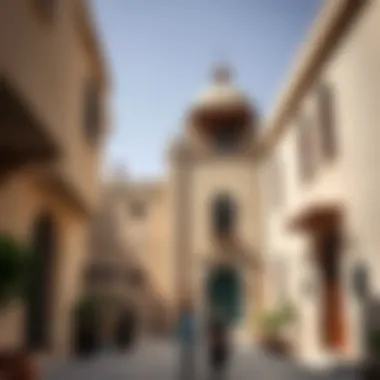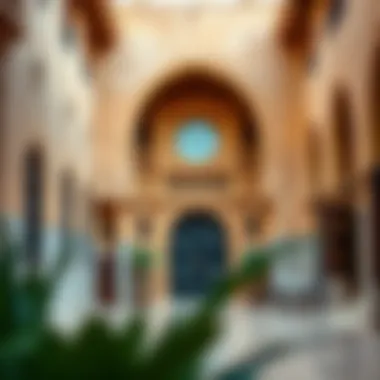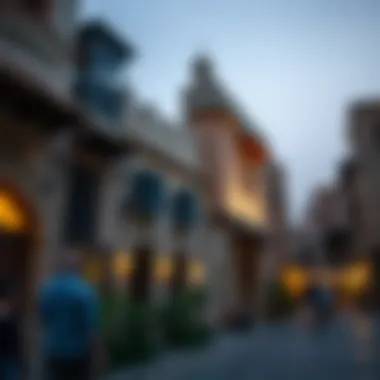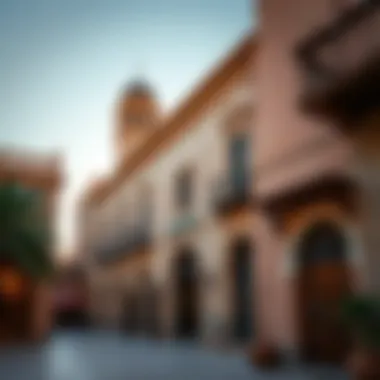Exploring Bastakiya Quarter: Dubai's Cultural Heritage


Intro
Nestled within the vibrant cityscape of Dubai lies the Bastakiya Quarter, a historical district that stands as a testament to the city’s rich tapestry of culture and heritage. This area, marked by narrow alleyways and traditional wind-tower architecture, invites visitors to step back in time, experiencing the essence of early Emirati life. The juxtaposition of this historical gem against Dubai’s sky-high towers may surprise many, yet it serves as a reminder of the city’s roots, representing a phase of growth before the era of rapid modernization began.
Bastakiya conveys stories of a bygone era, where trade and commerce flourished through its bustling markets and vibrant community. As we traverse through the heart of this district, we not only appreciate its architectural beauty but also examine its evolving role within Dubai’s ever-changing real estate landscape. The blend of tradition and modernity found in Bastakiya provides a rich narrative for potential investors and real estate professionals, interested in understanding the lasting appeal of this remarkable quarter.
In our exploration, we will dive into the architectural significance and historical context of Bastakiya, look closely at current market trends, and highlight investment opportunities that can arise within this unique locale. Through this comprehensive guide, we aim to present a clear picture of both the cultural and economic facets that make Bastakiya a focal point in Dubai’s property market.
Prologue to Bastakiya Quarter
The Bastakiya Quarter stands as an essential piece of Dubai’s historical tapestry. This area reflects a blend of rich culture and tradition, while also providing insight into the city’s rapid evolution. Understanding the Bastakiya Quarter is not just about appreciating its old buildings and narrow lanes; it's about grasping the significance of how history intertwines with modernity in a city that is constantly reinventing itself.
Significance of the Quarter
Bastakiya, also known as Al Fahidi Historical Neighborhood, is often seen as the heart and soul of Dubai. As the economy shifted over the years, this area remained a constant reminder of the Emirati heritage. Investors looking at properties in Dubai should pay close attention to this district because it exemplifies how traditional architecture and contemporary lifestyle can coexist beautifully. The blend of cafes, galleries, and boutiques against the backdrop of historical wind towers invites both tourists and locals to appreciate the impeccable craftsmanship that has survived the test of time.
Furthermore, the importance of this quarter extends beyond its architectural beauty. It provides a platform for local artists and entrepreneurs, thus fueling a growth that doesn’t sacrifice authenticity for commercial gain. This dynamic creates unique opportunities for investors. One of the key benefits is the potential for developing businesses rooted in authenticity, taking advantage of the influx of visitors drawn to the district's cultural significance.
Historical Background
Tracing back to the late 19th century, the Bastakiya Quarter was established by Persian merchants attracted to the thriving coastal trade of the Gulf region. These merchants brought with them their architectural style, which is evident in the area's significant features such as alleyways that connect modern life with a bygone era.
The layout of Bastakiya is intentional; it caters to the desert climate. The high walls of buildings and the famous wind towers are designed to provide natural ventilation. These architectural decisions, dictated by both necessity and aesthetics, stand as a testament to the ingenuity of the past. The quarter remained relatively untouched until the early 2000s when preservation efforts began, leading to its current status as a protected heritage site.
In recent years, the area has seen an influx of cultural projects and arts events, shedding light on its historical significance. Programs designed to educate visitors about traditional crafts and customs have become common, attracting a diverse array of crowds. Investors interested in heritage tourism will find a fertile ground for unique opportunities as Bastakiya continues to evolve while honoring its rich past.
"Bastakiya not only showcases Dubai's past but also inspires its future, creating a dialogue between old and new."
Whether one is lounging in a quiet courtyard, enjoying an art exhibit, or considering investment, the Bastakiya Quarter offers an experience laden with depth that no visitor or potential investor should overlook.
Overall, understanding the Bastakiya Quarter is crucial for anyone who wishes to grasp the broader narratives that shape Dubai. Its blend of history, culture, and market potential positions it as a focal point that demands attention from investors and historians alike.
Architectural Features
The architectural features of Bastakiya Quarter are of significant importance owing to their representation of traditional Emirati design and lifestyle. These elements are not mere decorative aspects; they reflect the cultural heritage and historical practices of the region. Investors, buyers, and real estate professionals should pay great attention to these details, as they can reveal much about the value and potential of properties within this historic district.
Wind Towers
Wind towers, or barjeel, are perhaps the most iconic structures found in Bastakiya. These ancient cooling systems exemplify the ingenuity of local architecture in response to the harsh desert climate. Rising majestically above the buildings, wind towers capture breezes from various directions and funnel them down into the living spaces below. This passive cooling method not only shows clever design but also symbolizes a sustainable approach to construction long before modern techniques were developed.
Investors should appreciate that wind towers represent a unique selling point for properties in the area. They are more than just architectural features; they are a testament to the cultural identity of Dubai. In an era where sustainability is at the forefront of real estate development, these towers illustrate a historical commitment to environmental considerations. The unrelenting charm of these structures contributes to the aesthetic value of the quarter and enhances the marketability of adjacent properties.
Traditional Buildings


The traditional buildings in Bastakiya Quarter offer a window into the architectural framework of early Emirati society. Constructed from coral stones and mud, these structures were designed to provide not only shelter but also community spaces where families gathered. The mud plaster used in construction acts as an effective thermal insulator, maintaining cooler temperatures inside throughout the summer months.
Many buyers and developers might find it appealing to invest in or restore these traditional homes for various reasons:
- Cultural Heritage: Owning a piece of Bastakiya is akin to holding a slice of Dubai's history.
- Unique Character: Each building has its unique character, unsurpassed by modern developments.
- Potential for Restoration: There are various opportunities to innovate while respecting the history of these structures, which can significantly increase property value.
Real estate professionals should guide buyers on the potential for rehabilitating these buildings into quaint dwellings or boutique hotels. Encapsulating the traditional essence while modernizing for comfort can drive significant interest in properties.
Cultural Influences
The architectural style of Bastakiya embodies a mosaic of cultural influences that narrate the stories of traders, explorers, and diverse communities that have passed through Dubai over centuries. The quarter displays styles influenced by Persian and Indian designs, reflecting the once-bustling trade routes.
This cultural richness offers investors an opportunity to engage with a unique market segment. Properties that exhibit this eclectic mix not only attract tourists but also cater to locals eager to reconnect with their roots. The cultural influences in Bastakiya can be leveraged to create themed hospitality or retail spaces that celebrate this fusion of heritage.
Investing in the architectural features and understanding their cultural implications allows stakeholders to create offerings that resonate with those interested in both modern living and historical significance.
Understanding Bastakiya's architectural landscape can provide insights for informed real estate decisions.
Socio-Economic Evolution
The socio-economic evolution of Bastakiya Quarter encompasses a tale of transformation, adaptation, and resilience. Once a bustling center for Persian merchants, this area has witnessed significant changes, reflecting broader shifts in Dubai’s economy. Understanding this evolution is crucial, especially for investors and real estate professionals contemplating opportunities within this historic enclave.
Development of the Quarter
Bastakiya, originally established in the early 1900s, thrived as a community with trade taking center stage. The narrow lanes, traditional buildings, and essential wind towers characterize its original design. Back then, the quarter was more than just a market; it was a hub for culture and connection among traders from Persia, India, and East Africa.
As the demand for modernization grew, the redevelopment of this historical area began to take shape in the late 20th century. The Dubai government prioritized bastions of heritage, ensuring that Bastakiya’s architectural and cultural integrity was maintained while simultaneously facilitating new investments.
- The establishment of the Sheikh Mohammed Centre for Cultural Understanding in 1998 marked a pivotal point in preserving the quarter’s identity while promoting cultural exchange.
- The strategic investment into infrastructure led to enhanced accessibility, turning Bastakiya into a prime spot for tourists and investors alike.
Impact of Modernization
The shift towards modernization is palpable in Bastakiya, with contemporary influences blending seamlessly with its rich history. The introduction of modern amenities, coupled with preservation efforts, plays a key role in the quarter's evolution.
While progress is often viewed through the lens of financial gain, it's equally vital to appreciate its cultural ramifications. Here are a few notable impacts:
- Cultural Revitalization: Festivals and art exhibitions draw local and international crowds, fostering a cultural revival that reinforces community bonds and attracts investors.
- Economic Opportunities: Real estate developments are now fashionable in Bastakiya, with boutique hotels and galleries popping up, providing ample chances for those in the industry.
- Gentrification Challenges: As luxury developments encroach upon traditional spaces, the delicate balance between preserving history and accommodating growth comes into question.
"Modernization must be approached with a discerning eye; we can't let commercial interests overshadow the heritage that makes places like Bastakiya unique."
The ongoing interplay between modernization and historical preservation is pivotal for new investors. Those looking to engage with this area must navigate both the opportunities presented and the challenges that arise from rapid change. The future of Bastakiya is a balancing act of honoring its illustrious past while embracing its evolving presence within Dubai's real estate landscape.
Cultural Significance
The cultural significance of the Bastakiya Quarter transcends mere architectural beauty; it serves as a living tapestry that reflects the history, traditions, and evolution of Dubai. This area is not just a collection of old buildings; it holds stories and memories that bind the community. Bastakiya embodies the essence of Dubai's past while providing a platform for current cultural expressions and events. The juxtaposition of its ancient structures against a backdrop of modernity demonstrates how Dubai values its heritage while embracing progress.


Festivals and Events
Festivals and events in the Bastakiya Quarter play a pivotal role in celebrating and reviving local culture. Throughout the year, the quarter serves as a venue for various events, including the Dubai Art Season, which showcases local artists and global talents. These gatherings are not solely about entertainment; they are an opportunity for dialogue, reflection, and connection among diverse communities.
- Art Dubai is an annual highlight, shedding light on both traditional Middle Eastern art forms and contemporary practices. Artists display their works in the galleries nestled between the historic buildings, fostering a vibrant exchange not only among artists but also with visitors from around the world.
- Ramadan Nights is another significant event. During this holy month, Bastakiya transforms into a hub of cultural and spiritual activities. Local mosques and cultural centers offer Iftar meals, where communal gatherings strengthen relationships and serve as a reminder of generosity—a core value in Emirati culture.
These events exemplify how Bastakiya remains a cultural beacon, inviting residents and tourists to immerse themselves in the rich traditions of the UAE.
Art and Exhibitions
Art and exhibitions within the Bastakiya Quarter draw from a well of inspiration found in the region's unique heritage. The venues here, such as the Sheikh Mohammed Centre for Cultural Understanding, offer not only exhibitions but educational programs that aim to bridge cultural gaps.
- Gallery 76 and Alserkal Avenue frequently host exhibitions featuring works by Emirati and indigenous artists, showcasing compelling narratives tied to their identity. The art displayed is not confined to walls; it spills into the streets, transforming the very fabric of the quarter.
- The emphasis on interactive installations encourages visitors to engage rather than merely observe, fostering a deeper understanding of the cultural dialogues at play. This artistic approach reinforces the notion that culture should not be static but instead an ever-evolving entity, influenced by both historical context and contemporary issues.
In summary, the cultural significance of the Bastakiya Quarter is evident through its festivals, events, and art exhibitions, all of which contribute to a rich narrative about Dubai's identity. For investors and developers, recognizing this cultural layer can offer angles for engagement that go beyond the mere bricks and mortar of real estate; it’s about fostering a community that honors its past while reaching for the future.
"Bastakiya isn't just about history; it's where history breathes and shapes tomorrow."
By investing in this quarter, you are not only securing a piece of property but also becoming part of a living history that is continuously written by its inhabitants.
Bastakiya in Contemporary Dubai
The Bastakiya Quarter stands not only as a portal to Dubai’s storied past but also plays a crucial role in the city’s modern-day landscape. In a region marked by rapid development and economic growth, Bastakiya serves as a vital reminder of the roots of Emirati culture. As the city continues to evolve, understanding the quarter's relevance in contemporary times becomes essential, particularly for investors, developers, and real estate professionals looking to navigate Dubai's unique market.
Tourism and Visitor Engagement
Tourism has become a cornerstone of Dubai's economy, and Bastakiya is a jewel in this bustling sector. Visitors seeking a taste of authentic Emirati culture flock to the narrow lanes and traditional buildings that define the quarter. Engaging with the past becomes more than just a casual stroll; it's an experience painted with the art and spirit of the ages.
- Authentic Experiences: Tourists can indulge in various cultural activities, from workshops on traditional crafts to art exhibitions in galleries such as the Sheikh Mohammed Centre for Cultural Understanding. Each interaction fosters a deeper understanding and respect for Emirati heritage.
- Culinary Adventures: With eateries serving traditional dishes, visitors revel in the flavors of Dubai that echo centuries of history. Diners can savor everything from aromatic spices to freshly baked bread, all within the historically rich environment of Bastakiya.
- Guided Tours: Engaging professional guides provides a richer context and appreciation for the architecture and history of the area. They illuminate stories that often go untold, making the rich narrative of the quarter accessible to all.
"Bastakiya offers an immersive glimpse into a time when Dubai was a trading hub, not just a tourist destination."
Integration with Urban Development
Balancing the old while embracing the new is no small feat, yet Bastakiya illustrates this integration impeccably. As developers and city planners eye the future, the quarter operates as a blueprint for blending heritage with modernity in urban development.
- Sustainable Preservation: Ongoing efforts focus on maintaining the integrity of the traditional buildings while modernizes the infrastructure. This approach underlines the commitment to preserving the soul of Bastakiya amid the skyline growth.
- Public Spaces: New parks and recreational areas are being integrated to enhance visitor experience while maintaining an aesthetic that echoes the quarter's architectural ethos. These spaces become vital for community gatherings and cultural events.
- Investment Opportunities: For real estate investors, Bastakiya increasingly represents a unique opportunity. Properties that celebrate the historic character of the area often command significant attention, blending the charm of heritage with the demands of modern living.
This intricate relationship between preservation and progress positions Bastakiya not just as a historical site but as a dynamic component of Dubai’s urban landscape, inviting investors, visitors, and locals to engage with its multifaceted narrative.
Real Estate Dynamics
The Bastakiya Quarter is not just a historical landmark; it represents a unique confluence of heritage and real estate potential in the heart of Dubai. As the city evolves, understanding the real estate dynamics of this area becomes essential for anyone interested in the property market. This section outlines the various aspects of Bastakiya's real estate landscape, emphasizing investment opportunities and prevailing market trends.


Investment Opportunities
Investors looking for diverse portfolios should consider Bastakiya. The allure of historic neighborhoods paired with Dubai's modern infrastructure makes this quarter an enticing prospect. Here are some key investment points:
- Cultural Heritage Preservation: Properties in Bastakiya are often protected by heritage laws. This not only helps maintain their value but also attracts buyers interested in cultural tourism.
- Rising Tourism: The quarter has become a hub for cultural tourism. With festivals and art exhibitions held throughout the year, property investments can yield rental returns during peak visitor seasons.
- Developing Infrastructure: Continued investment in surrounding areas means that Bastakiya is likely to see appreciation in property values as accessibility and amenities improve.
"Investing in a heritage area can be a double-edged sword; while appreciation is promising, understanding local regulations is vital."
Focusing on the purchase of commercial spaces suited for galleries or cafés could be particularly worthwhile, given the influx of tourists. Furthermore, residential properties offer a potential for growth, especially in shared living settings, tapping into the desires of younger expats and locals.
Market Trends
Analyzing current market trends within Bastakiya involves a close look at both buyer behaviors and the broader economic landscape. Here are notable trends worth noting:
- Adaptive Reuse of Properties: Many older buildings are being transformed into modern spaces while retaining their authentic charm. This strategy attracts both buyers and tenants who appreciate the blend of old and new.
- Increased Interest from Overseas Buyers: As Dubai continues to gain international recognition as a real estate hotspot, more foreign investors are eyeing Bastakiya for both residential and commercial purposes.
- Sustainable Developments: The trend toward eco-friendly construction and renovations is rising. Properties that implement sustainable practices are often favored by buyers concerned with environmental impact.
- Gentrification vs. Preservation: While modernization is often seen as beneficial, there's a thin line between vibrant development and loss of the area's historical identity. Investors must be aware of community sentiments to navigate possible pushback.
Understanding these trends can position investors to make informed decisions and seize new opportunities that arise within this historical yet evolving landscape. As the quarter continues to develop, the potential for significant returns on investment remains high, provided due diligence is performed.
Challenges and Preservation
The Bastakiya Quarter, while a treasure trove of history, faces significant challenges in its preservation. This section delves into how the preservation of this historic district is not merely about maintaining structures but about striking a delicate balance between modernization and the integrity of the heritage.
Balancing Change and Heritage
As Dubai evolves, the clashes between development and conservation become ever more pronounced. Investors and developers see the potential of Bastakiya's unique charm but also eye the real estate opportunities that modernization can bring.
The challenge lies in how to accommodate new projects without compromising the very elements that make Bastakiya significant. This means that any new construction must carefully consider the historical context. To remain appealing to both tourists and locals, enhancements should enhance, not overshadow, the aesthetic of traditional elements.
"Preservation is not only about saving bricks and mortar. It’s about preserving the stories and the culture embedded within them."
This sentiment guides both preservationists and urban planners. For example, community engagement in planning activities is essential. Well-informed stakeholders can voice their opinions about what changes are acceptable while still retaining the unique identity of this historical landmark.
Conservation Efforts
The conservation efforts in Bastakiya are multifaceted and involve a range of actions aimed at safeguarding its architectural heritage. Various stakeholders, including governmental bodies, NGOs, and local communities, are rallying to ensure the quarter remains a vibrant part of Dubai's tapestry.
Some key preservation initiatives include:
- Restoration Projects: Many of the district’s traditional buildings are undergoing restoration to maintain structural integrity while also ensuring aesthetic fidelity to their original construction. The Dubai Culture and Arts Authority often spearheads these efforts.
- Public Awareness Campaigns: Educating both residents and visitors about the historical significance of Bastakiya is vital. Many campaigns focus on promoting cultural events that celebrate the district's rich legacy, ensuring that locals and tourists appreciate its value.
- Sustainable Practices: Integrating sustainable materials and practices into restoration projects helps preserve both the physical structures and the environment. For instance, using traditional building techniques not only respects history but also ensures structures can cope with modern challenges.
Finale
As we wrap up our exploration of the Bastakiya Quarter, it becomes clear that this historic district holds immense significance in the broader narrative of Dubai's evolution. The juxtaposition of ancient traditions against the backdrop of modernity creates a unique atmosphere that resonates with both residents and visitors alike.
Future of Bastakiya
Looking ahead, the future of Bastakiya seems poised for a fascinating transformation. While the quarter has maintained its historical integrity, there’s an ongoing conversation about how to incorporate contemporary elements without overshadowing its charm. Potential areas of development could include:
- Renewed focus on cultural events: Boosting community engagement through art festivals, markets, and other activities. This not only attracts tourists but encourages local investment and participation.
- Sustainable restoration practices: Implementing eco-friendly renovation techniques could become a standard. Conservation efforts that prioritize renewable materials and sustainable energy can blend the old with the new while staying true to the quarter's heritage.
- Real estate prospects: For investors, the potential to develop boutique hotels or galleries could redefine the market landscape. The demand for unique, character-filled spaces continues to grow, making Bastakiya an attractive option for forward-thinking developers.
"Bastakiya is not just a destination; it is a symbol of Dubai's journey through time".











